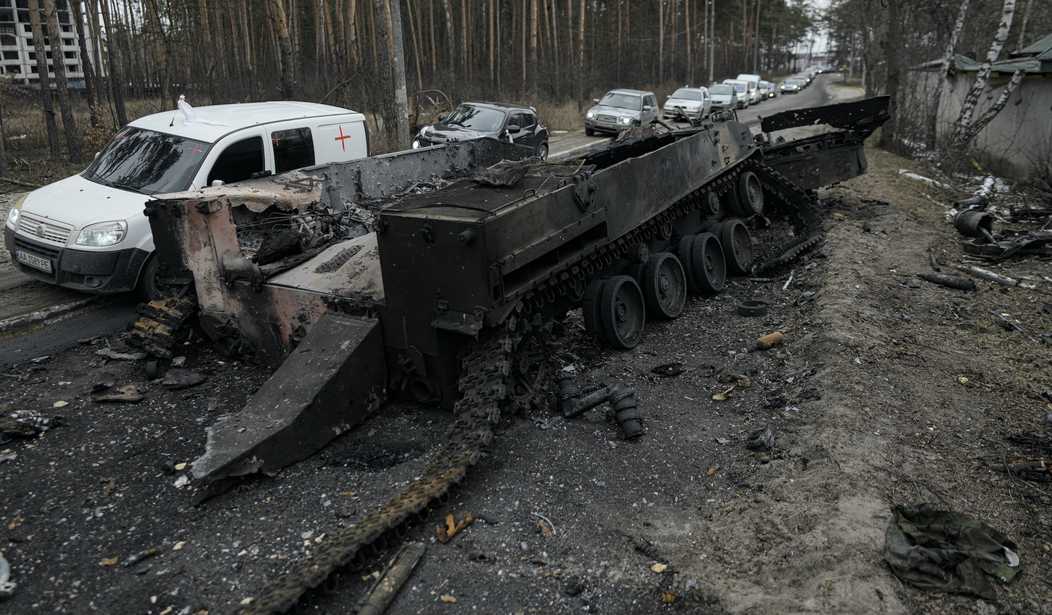This comes from the general staff of Ukraine’s armed forces, which means it’s time for another round of everyone’s favorite game when processing war news, “Truth or propaganda?”
If it’s propaganda, it’s at least not outlandish. Given how comprehensively Russia has been cut off from western suppliers and how poorly they seem to have planned for the war, it’s conceivable that their military would be running into shortages already.
And considering how tanks have been prized targets for Ukraine’s Javelin- and NLAW-supplied military from the start, it’s also conceivable that Russian demand for replacement parts has quickly soared far beyond what the country is able to supply.
Occupation troops operating in Ukraine feel the urgent need for repair and restoration of damaged weapons and military equipment. According to the available information, due to the lack of revenues of nadhodženʹkogo foreign production, the work of the enterprises of the Uralzavod Corporation and the Chelyabinsky tractor plant has been suspended. The specified companies specialize in the manufacturing and repair of tanks, as well as other armored equipment for the Russian Federation armed forces needs.
Elsewhere in the post, the Ukrainians specify that it’s “foreign-made components” in particular that the Russians are reportedly lacking. That called to mind Putin’s disastrous decision last week to nationalize the assets of western companies that have suddenly pulled out of Russia. Not only was that foolish, discouraging western businesses from returning to the country once sanctions are lifted, but those assets will soon be useless. Where is Russia going to get the spare parts needed to operate the passenger jets they’ve seized, for instance?
Fortune believes it’s possible that Russian tank production and repair has sputtered. That was the point of sanctions, after all:
Western allies, including the United States and the European Union, have ordered a complete halt to the export of certain components like microchips to Russia as part of an escalation package of sanctions.
So-called dual-use goods have been banned, since they can be employed for both military as well as civilian applications.
“Our aim is to reduce the Kremlin’s capacity to wage war on its neighbor,” EU Commission President Ursula von der Leyen explained earlier this month.
It may be working. Halting the manufacture and repair of T-72B3s, as well as more advanced but less numerous T-80s and T-90s, could hobble Russia’s efforts to continue its advance across war-torn Ukraine.
Russia should probably worry less about replacing tanks than replacing the soldiers equipped to operate them. Ret. Gen. Mark Hertling, a tank expert, explained yesterday that Russian tanks are death traps for their crews when they come under attack. He saw the interior of a Russian tank in 1994, a new model at the time which the country was proud of, and was amazed at the lack of precautions taken to increase the likelihood of survival if hit. And tanks aren’t the only Russian vehicles with that problem:
Now, I share all this to say:
RU tanks are matchboxes.
-crews have a hard time seeing attacking infantry
-there is no reactive armor on top (where Javelins strike)
-if hit, they'll burn, with secondary explosions
-if hit, the crew will have a tough time getting out. 16/— Mark Hertling (@MarkHertling) March 21, 2022
Russian Fuel, Ammo, and supply (medical, parts, etc) trucks are all the same design.
And from what I saw on exercises, RU troops pack as much as they can in each truck, sometimes mixing cargo.
Not good for crew survivability, if the truck is hit. 18/
— Mark Hertling (@MarkHertling) March 21, 2022
Combine that with the fact that Ukrainians are overflowing with anti-tank weapons and the war is a turkey shoot to some degree, leading Hertling to believe that the reports of high Russian casualties might actually be understating their true losses. The latest:
🇷🇺 commander of the of engineer troops of the 1st Guards Tank Army, colonel Nikolay Ovcharenko of 45th separate engineering brigade + 18 of his unit were killed by 🇺🇦 forces near Izium. 46 WIA. This unit spent 1980-89 in Afghanistan. pic.twitter.com/b6ObWJNzaA
— Eerik N Kross (@EerikNKross) March 21, 2022
Russia never has cared much about the lives of its soldiers, which is why money appropriated for better equipment tends to end up purchasing well-appointed dachas for members of siloviki instead. Go figure that some of those soldiers aren’t motivated to fight to the bitter end for the glory of the homeland:
Ukrainian Ministry of Interior reports that a Russian soldier turned his tank over to the Ukrainians. He'll get 10 thousand usd and the opportunity to apply to citizenship. That's great: defection and sabotage among the Russian military should be encouraged and scaled up pic.twitter.com/ksVbxJpMpj
— Kamil Galeev (@kamilkazani) March 22, 2022
You may be tempted from all this to conclude that tank warfare in an era of drones and NLAWs is obsolete in principle but that’s probably not true. Tank warfare *as practiced by the Russians* is obsolete, partly because of what Hertling says about the inherent dangers of their transports and partly because of Russia’s shocking failure to take basic tactical measures to protect its tanks better. Mark Antonio Wright published this assessment of Russian tactical failures on day three of the war, noting how their tanks were left exposed to Ukrainian attack because they weren’t accompanied by mechanized infantry. A month later, there’s no reason to believe the problem has been solved. That’s one of the great surprises of the past month. Any army can run into trouble due to unexpected problems but it takes a truly weak army not to be able to correct its mistakes.







Join the conversation as a VIP Member